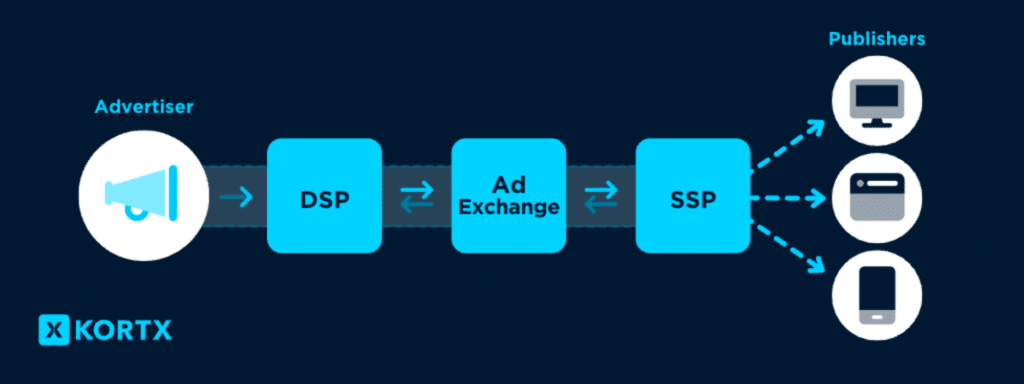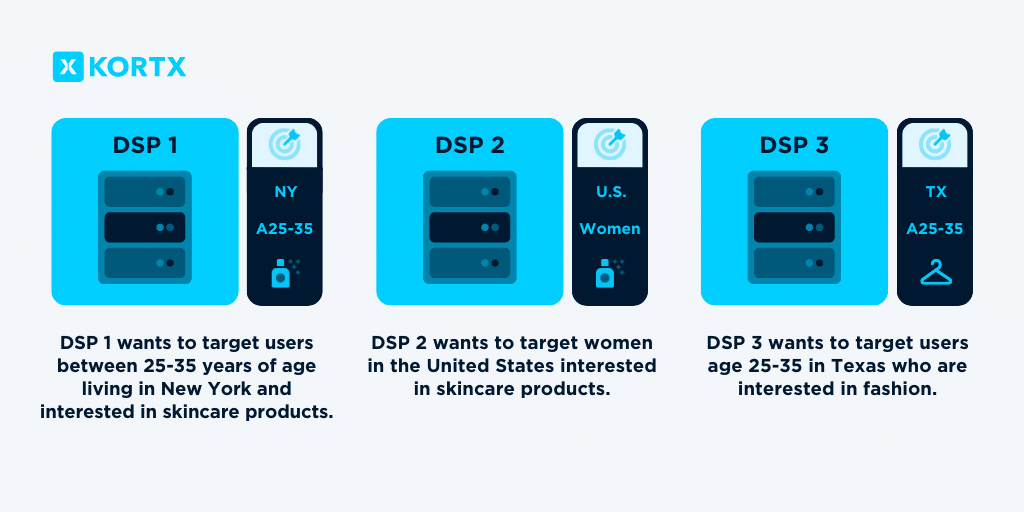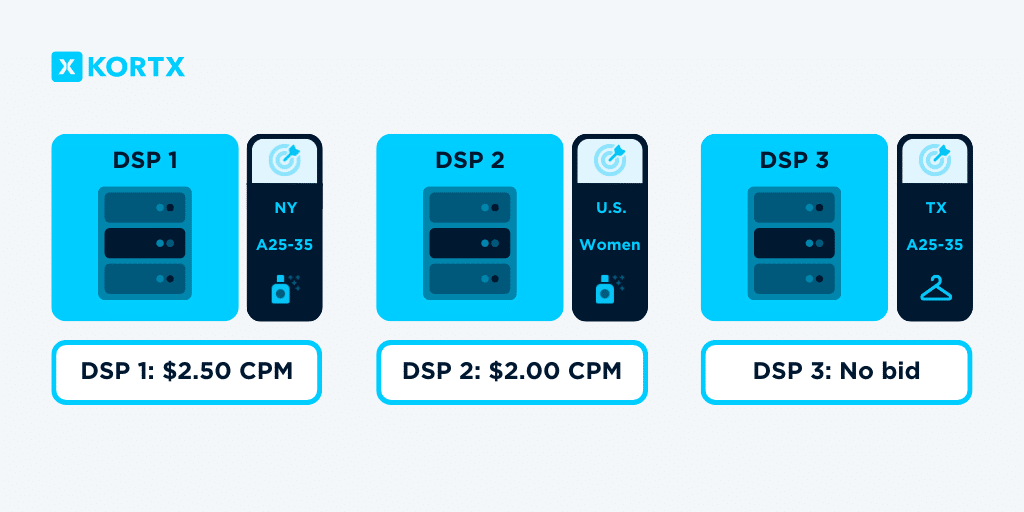Since their launch in 2007, DSPs (demand-side platforms) have made buying digital advertising inventory easier. Advertisers can buy targeted digital ad space across multiple channels, including display, video, mobile, and connected TV (CTV) near instantly.
Businesses leverage DSP data to identify key audiences, personalize user experiences, boost online visibility, increase brand awareness, and track how CTV ads drive on-site conversions.
Definition: What is a Demand-Side Platform (DSP)?
A demand-side platform (DSP) is an automated tool that lets marketers buy and manage ad inventory from multiple sources in one place. Its key advantage is the ability to control all digital ads across various networks from a single interface.
For example, if a user logs into Facebook and sees an ad, the DSP allows you to target this same user on Google and across other sites they visit—all within a single campaign.

An example of a DSP interface.
Before DSPs, advertisers had separate platforms for a single campaign and contacted hundreds of publishers with offers to advertise. DSPs make ad buying faster, more efficient, and cheaper.
There are two demand-side platform types:
- Self-serve: This allows advertisers to create and maintain ad campaigns without assistance, giving advertisers full control over campaign execution and reducing overhead costs.
- Full-service: This option allows advertisers to outsource ad campaigns to a sales representative and account manager. Since an external team manages the campaign, advertisers must commit to a minimum budget when using a full-service DSP.
Self-serve DSPs are best for experienced advertising companies or agencies that want autonomy and campaign transparency on a smaller budget.
Full-service DSPs are best for companies with large budgets wishing to outsource their campaign work.
Advertising networks vs demand-side platforms:
Ad networks (not to be confused with ad exchanges) and DSPs aren’t the same and have different functions.
Ad networks aggregate and sell advertising inventory from multiple publishers to advertisers, matching ads to appropriate websites to reach the desired audience.
DSPs allow advertisers to purchase ad inventory from a wide range of ad exchanges and networks through RTB (real-time bidding). Advertisers can target specific audiences and manage multiple campaigns from a single interface.
Ad networks sell ad inventory, while DSPs buy ad inventory for advertisers.
What is the Difference Between SSPs vs DSPs
DSPs and SSPs integrate with ad exchanges but serve opposite sides of the market. Here are the key differences between the two:
DSP (Demand-Side Platform): Advertisers and agencies use DSPs to purchase digital advertising inventory from various ad exchanges and SSPs. DSPs allow buyers to reach their target audience efficiently by purchasing ad spaces that meet specific criteria such as demographics, interests, behaviors, and more.
SSP (Supply-Side Platform): On the other hand, supply-side ad platforms are used by publishers to manage, sell, and optimize available inventory on their websites or mobile apps. With SSPs, publishers can offer their inventory to a wide range of potential buyers through ad exchanges and DSPs.
Simply put, the DSP is on the demand (buyer) side of the process, and the SSP is on the supply (selling) side of the programmatic advertising ecosystem.
With a clear understanding of what a DSP is, let’s delve into how a demand-side platform operates.
How Does a Demand-Side Platform (DSP) Work?
Automated, real-time bidding (RTB) is the skeleton of a DSP. With RTB, the advertiser sets a unique bid for every ad impression and competes for this impression during a real-time auction.
The real-time bidding process has two parties, the publisher vs the advertiser:
- The publisher: the owner or “seller.”
- The advertiser: the buyer.
And two platforms:
- The SSP: used by publishers
- The DSP: used by advertisers
DSPs work within the real-time bidding process like this:
- The publisher posts their available ad space inventory or audiences on the DSP through ad exchanges and SSPs (supply-side platforms).
- The ad exchange and SSPs send the updated inventory and/or audience information to the DSP.
- The advertiser selects their target audience segments using data like location, age, previous online behavior, and more.
- If the visitor on a publisher’s website matches the advertiser’s targeting criteria, the DSP bids on that impression using either CPM (cost per mille) or CPC (cost per click) pricing models.
- The DSP automatically buys the impression for the highest-bidding and most relevant advertiser.
- After winning the bid, the ad appears on the publisher’s website.
This process happens within roughly 100 milliseconds when a visitor views the publisher’s site.

How the RTB process works.
For example,
- An advertiser for a New York skincare brand wants to reach women ages 25-35 in New York. They set their DSP to match this audience.
- Meanwhile, a publisher has ad space available on their site, and a 30-year-old woman visits. The website sends an ad request to the SSP, which is passed on to the ad exchange.
- The ad exchange notifies DSPs that a relevant ad slot is available, kicking off a bidding process.
Now, imagine three DSPs are competing for similar criteria.

While all three DSPs could benefit from showing their ad, DSP 1 stands to gain the most since it perfectly matches the target profile. The DSPs then evaluate the ad, compare it to their target criteria, and bid on the impression based on its relevance.
The bids might look like this:

After a DSP wins the bid for an impression, the ad is sent back to the website and shown to the user. This happens each time someone visits or refreshes the page.
Now that you understand how a DSP works let’s examine the advantages and disadvantages of using a demand-side management platform.
Why Use a DSP?
Despite a few limitations, DSPs are essential for modern advertisers. They bridge the gap between target audiences and publisher inventory, using data to find the most effective ad spaces for optimal performance.
Without DSPs, programmatic advertising would revert to a manual “Stone Age” process, wasting time and ad spend.
What was life like for advertisers before using DSPs?
“Before DSPs, programmatic advertising was a manual, non-transparent process akin to being faxed a digital media performance report. The digital media industry was similar to living in a house with a lot of potential but no plumbing in place. Upfront agreements were done via a publisher rolodex in hopes of quality inventory. The modern-day version of a DSP connects the audience to inventory. This shift from a manual and complicated process to automation has greatly improved the programmatic advertising supply chain.”
1. Real-time bidding for faster ad placements & refined targeting.
Real-time bidding lets advertisers bid on ad inventory instantly, helping them compete for the impressions they need to effectively reach their target audience.
Advanced targeting features allow advertisers to pinpoint their ideal audience by factors like interests, location, and browsing habits. This results in higher engagement and conversions.
2. Improved ad performance & ROI potential.
DSPs can greatly enhance ad performance and boost return on investment (ROI). In the 2020 State of Programmatic Advertising survey, 70% of respondents cited success from their programmatic campaigns, and 23% described their campaigns as highly successful.
DSPs also enable real-time optimization and adjustments based on performance data, driving higher conversion rates and improving overall ROI.
3. Access to a virtually limitless ad inventory pool.
DSPs connect advertisers with a vast network of supply-side platforms (SSPs), ad exchanges, and publishers, giving them access to an almost limitless pool of ad inventory.
This allows advertisers to scale their campaigns and reach millions of potential customers across websites, mobile apps, and other digital channels. The broader inventory access increases reach and improves the chances of hitting target audiences, leading to more successful campaign outcomes.
Why should advertisers use DSPs?
“If you want to purchase digital media inventory on the open internet and compete against others for ad space in front of valuable customers, you’d need a DSP to provide the best benefit for your investment.””
4. Automated campaign management to help free up time for advertisers.
DSPs leverage advanced technology to automate the buying and placement of online ads, saving advertisers valuable time.
Tasks are handled automatically, like:
- ad placement
- bid management
- budget allocation
- performance tracking
This allows advertisers to focus on the strategy and creative elements of their campaigns.
5. Data to make smarter decisions.
DSPs offer a comprehensive view of campaign performance, tracking metrics like impressions, clicks, and conversions. This real-time data empowers advertisers to optimize their campaigns by adjusting bids, targeting, and creative elements on the fly.
DSPs also provide valuable audience insights, including demographic and behavioral data, helping advertisers refine their targeting strategies and effectively reach their ideal audience.
What are the benefits of activating First-Party data?
“First-Party data is one of the most valuable assets for brands seeking an advantage in digital media. The ability to capture, segment, and activate against these data sets provides the opportunity to directly engage with potential and existing customers.”
6. First-Party data to engage with potential & existing customers.
DSPs enable advertisers to activate their own First-Party data, such as customer information and purchase history, to target specific audience segments with personalized ads.
They also integrate with Third-Party data providers, adding extra layers of insights that enhance First-Party data and improve overall campaign performance.
What are some disadvantages & the reporting limitations of a DSP?
““There isn’t a lot of differentiation between different DSPs regarding the inventory types offered, the audience targeting methodologies available, and the partners. Many DSPs have a limited data retention period, requiring additional investment to expand the data set and visualize historical data into actionable reports. Examples include log-level data, ad servers and automated reporting solutions.”
Top Demand-Side Platform (DSP) Marketing Platform Examples
DSPs allow advertisers and agencies to purchase ad inventory from many sources through a single interface.
Here are some of the best Demand-Side Platform (DSP) examples:
- Google Marketing Platform: Part of Google Marketing Platform, DV360 offers a comprehensive suite for buying ad inventory programmatically. It’s known for its vast reach, advanced targeting options, and integration with various data sources and Google tools.
- The Trade Desk: A highly regarded independent DSP, The Trade Desk provides a wide range of ad formats, including display, video, audio, and native ads. It’s appreciated for its user-friendly interface and robust analytics capabilities.
- Xandr (Formerly AppNexus): Acquired by AT&T and rebranded as Xandr, AppNexus is known for its powerful programmatic ad-buying capabilities, offering diverse inventory across various channels.
- Criteo: Specializing in retargeting, Criteo uses machine learning to deliver personalized ads. It’s particularly effective for eCommerce businesses looking to re-engage customers.
- Simpli.fi: This DSP is tailored for localized programmatic advertising, offering unique solutions like geo-fencing and localized search retargeting, ideal for businesses with a strong local presence.
- Basis Technologies: Known for its ease of use and comprehensive digital media planning tools, Centro Basis is designed to streamline the ad-buying process, making it accessible even to smaller advertisers.
- Adobe Advertising Cloud: Part of the Adobe Experience Cloud, this DSP offers cross-channel advertising options, integrating well with Adobe’s suite of marketing tools for a seamless advertising experience.
Each DSP comes with its unique strengths, and the choice often depends on the specific needs and goals of the DSP advertising company, such as the type of audience they wish to target, the formats they prefer, and the level of control and transparency they require.
The Bottom Line: Understanding the Power of Demand-Side Platforms
By automating ad bidding and buying, DSPs help advertisers reach high-value audiences with personalized experiences. With two types of DSPs—self-serve and full-service—businesses of any size can find a solution that fits their needs.
Whether you’re a seasoned advertiser seeking autonomy and transparency or a company with a large budget looking to outsource, DSPs offer a cost-effective way to reach the right people at the right time. With a solid understanding of how DSPs work, you can turn your ad spend into real results.
🔎 Deeper programmatic insights start with KORTX.
Enhance your ads strategy by partnering with our expert team and discover tailored solutions that fit any budget.





